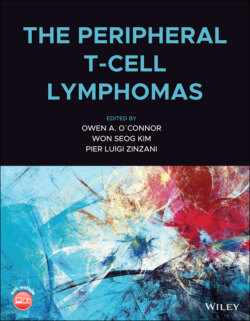Читать книгу The Peripheral T-Cell Lymphomas - Группа авторов - Страница 33
Angiogenesis
ОглавлениеAmong non‐Hodgkin lymphomas, PTCLs demonstrate the highest microvessel density [82]. Increased microvessel density has also been shown in cutaneous biopsies involved by mycosis fungoides in comparison with inflammatory skin conditions [83]. VEGF overexpression in PTCL, NOS has been associated with a poor outcome [84]. VEGF may result in local neovascular transformation (angiogenesis) and recruitment of circulating progenitors derived from the bone marrow (vasculogenesis) [85]. However, in contrast to AITL, it is unclear which cell type(s) release VEGF and whether VEGF receptors are present and functional on the lymphoma cells in PTCL, NOS. In models of NPM‐ALK‐driven oncogenesis, STAT3 induces VEGF expression by the lymphoma cells. MicroRNA‐135b is another mediator of NPM‐ALK‐mediated angiogenesis [86]. Elevated serum VEGF levels in patients with non‐Hodgkin lymphoma have been reported to be associated with a poor outcome [87]. Attempts to improve the outcome of patients with PTCL by adding bevacizumab have, however, proven ineffective [88].
Figure 2.2 Neoplastic T follicular helper cells and their microenvironment in angioimmunoblastic T‐cell lymphoma. B, B cell; EBV, Epstein–Barr virus; FDC, follicular dendritic cell; IL, interleukin; LT‐β, lymphotoxin‐beta; MAC, macrophage; PC, plasma cell; TFH, T follicular helper cells; TGF, transforming growth factor; Th1, T lymphocyte 1; Treg, T regulatory cells (gray arrows: epigenetic mutations, which may occur early and may be detected in neoplastic cells and other reactive cells including B cells; asterisk: additional mutations or somatic hypermutations; red arrows: T‐cell‐specific mutations like RHOA G17V or others.
Source: Adapted from de Leval and Gaulard [63].
